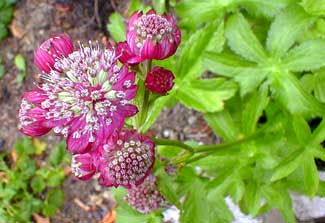
'Rose Symphony' Masterwort
"Are not they who possess the flowers
Stronger, bolder, shrewder
Than they who have none?"
-Stephen Crane
(1871-1900)
(1871-1900)
The German cultivar Astrantia major ssp involucrata var rosea 'Rosensinfonie,' in English translated 'Rose Symphony," was introduced in 1982. The umbles consist of numerous red, rose, purple & pink bracts. When grown from winter-sewn seed, it can be varied from plant to plant, but a really nice 'Rose Symphony' has bright rose-red bracts, with a shimmering nearly metallic quality.
Seedlings can take three years to clump up presentably, spreading very slowly by underground stolons. So it may be best to just buy a gallon-sized plant, selected while in flower to be sure of a particularly bright specimen. It grows to thirty inches height including the wiry flower stems, with deeply cut basal foliage.
Adaptable to many conditions, it does best in bright shade or dappled sunlight, in moist humusy soil. It won't bloom well in deep shade, but too much sun will make the basal leaves unsightly from stress. It cannot abide dryness; evenly moist yet well draining soil is best, but if there is a garden spot that is just too wet for most perennials, Masterwort can be worth trying even in overly wet positions.
It flowers June through August; if there is an interuption in flowering, cutting it back will start it up anew. The individual blooms last quite some while, making good cut flowers, & also dry well.
Native originally of the Swiss Alps, it has naturalized throughout Europe, & made it to England by 1596. It spread throughout central Europe & beyond because it was formerly grown everywhere as an edible vegetable & as a medicinal herb. It was primarily the root that was regarded as useful, having a peppery flavor, & long believed to treat stomach, bowel & lung complaints. Today it is no longer eaten & only rarely used medicinally. It has also been used as a bittering agent in alocholic beverages, & was once believed to be a remedy for delirium tremons.
Gerard called it Black Masterwort & at different times it has been called a Hattie's Pincushion Flower, Great or Greater Masterwort, Mountain Sanicle, & Gentleman's Melancholy. This last name seems to be a reflection of "Mourning Widow," a name for Scabiosa atropurpurea, the Pincushion flower worn by Victorian widows. Apparently men emulated that old tradition, but with the subtler Astrantia pincusion, though the gentlemen's "melancholy" could also be a hangover after a drunken binge, masterwort root being an alleged treatment for delirium tremons.
The genus name is a corruption of Ostrutium, which was in turn a corruption of Struthio. It's essentially the same word as Ostrich, doubtless because the feathery petals of the flower reminded someone of the fluffy tail feathers of ostriches.